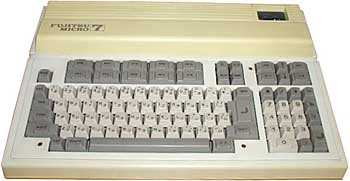

Fujitsu was (and still is) japan's leading electronics company. This computer was the succesor of theFM-8 itself first member of the Fujitsu FM (for "Fujitsu Micro") range of computers, extending from hobbyist home computers up to 16-bit machines for the business market.
The FM-7 was conceived as a cut-down version of the FM-8, eliminating the bubble cassette feature, and thereby achieving greater compactness and significantly lower price. But it also offered features not found on the FM-8, like a real sound synthesizer LSI providing 3 voices and 8 octaves. This made it the ideal hobby japanese computer at the time.
As the NEC PC series and the Sharp X1 and X68000, these computers were very very popular in Japan. They all had impressive characteristics in relation to the European and American computers counterparts.
The Most outstanding feature of the FM-7 was the quality and speed of the graphic display.
On the Japanese Computer Museum, one can read:
"Later, it developed into the FM-NEW7, which used high-integration memory and gate array LSI to reduce price while maintaining FM-7 functionality, and a high-end machine called the FM-77. From the start, the FM-7/77 series emphasized high-resolution color graphics and Japanese language display, and this trend continued with AV (Audio Visual) personal computers (beginning with the subsequent FM-77 AV) and the FM TOWNS hypermedia personal computer. The FM-7/77 machines laid the groundwork for Fujitsu's later hobby machines."
Nomura, Hisayuki reports:
Fujitsu FM 8 / 7 have a very unique feature. They have 2 CPUs. 1 for Main CPU (it's usual) and 1 for Graphics. Graphic CPU has their own boot ROM and main program. The Grapic CPU recieves request from Main CPU and draw pictures with their software. The two CPUs share small part of memory area and uses this shared area exclusively.
As another unique feature, the FM-7 can change its CPU. If optional Z-80A card is inserted, it can run CP/M. In this case, memory is shared by the two different CPUs.
Joerg Lemmer's memories:
We had the FM7 as our first "real computers" in school. As the teachers had no understanding in computers at all they first bought the FM7 and then found out that there was no software available for them in Germany. So Z80-cards were bought and installed. By this a modified CP/M could be used with just two applications: An early version of WordStar and TurboPascal. I am not sure, but I think there was dBase running on the FM7 later.
One teacher even started programming a library to use the outstanding grafic card of the FM 7 in TurboPascal. We had FM 7 with single and dual external 5,25'', 170KB Diskdrives.
| NAME | FM 7 |
| MANUFACTURER | Fujitsu |
| TYPE | Home Computer |
| ORIGIN | Japan |
| YEAR | November 1982 |
| BUILT IN LANGUAGE | FUJITSU F-BASIC Version 3.0 |
| KEYBOARD | Full-stroke 98 key with 10 function keys, arrow keys and numeric keypad. |
| CPU | MBL 68B09 |
| SPEED | 2 MHz |
| CO-PROCESSOR | second MBL 68B09 (Graphic & I/0) |
| RAM | 64 KB (30371 Bytes free with F-Basic) |
| VRAM | 48 KB |
| ROM | 48 KB |
| TEXT MODES | 80 x 25 / 80 x 20 / 40 x 25 / 40 x 20 |
| GRAPHIC MODES | 640 x 200 pixels |
| COLORS | 8 |
| SOUND | Programable Sound Generator, 3 channels, 8 octaves |
| SIZE / WEIGHT | 43.2 (W) x 28.5 (D) x 10.2 (H) |
| I/O PORTS | Tape, RGB, RS232, Joystick (2), ROM/RAM cartridges, BUS |
| BUILT IN MEDIA | Optional 5.25'' disk-drive. 10 or 20 MB hard disk |
| OS | Fujitsu Disk Basic , OS-9 (Microware), Flex (CP/M like DOS for 68xx CPU) |
| POWER SUPPLY | Built in Power supply AC100V 50/60Hz 70W |
| PERIPHERALS | Kanji ROM card, Z80 card, RS232c interface card, etc. |
| PRICE | �569 + �430 (Fujitsu monitor) |
 PCC [1978] PCC 2000
PCC [1978] PCC 2000
 Fujitsu [1985] FM 77 AV
Fujitsu [1985] FM 77 AV













